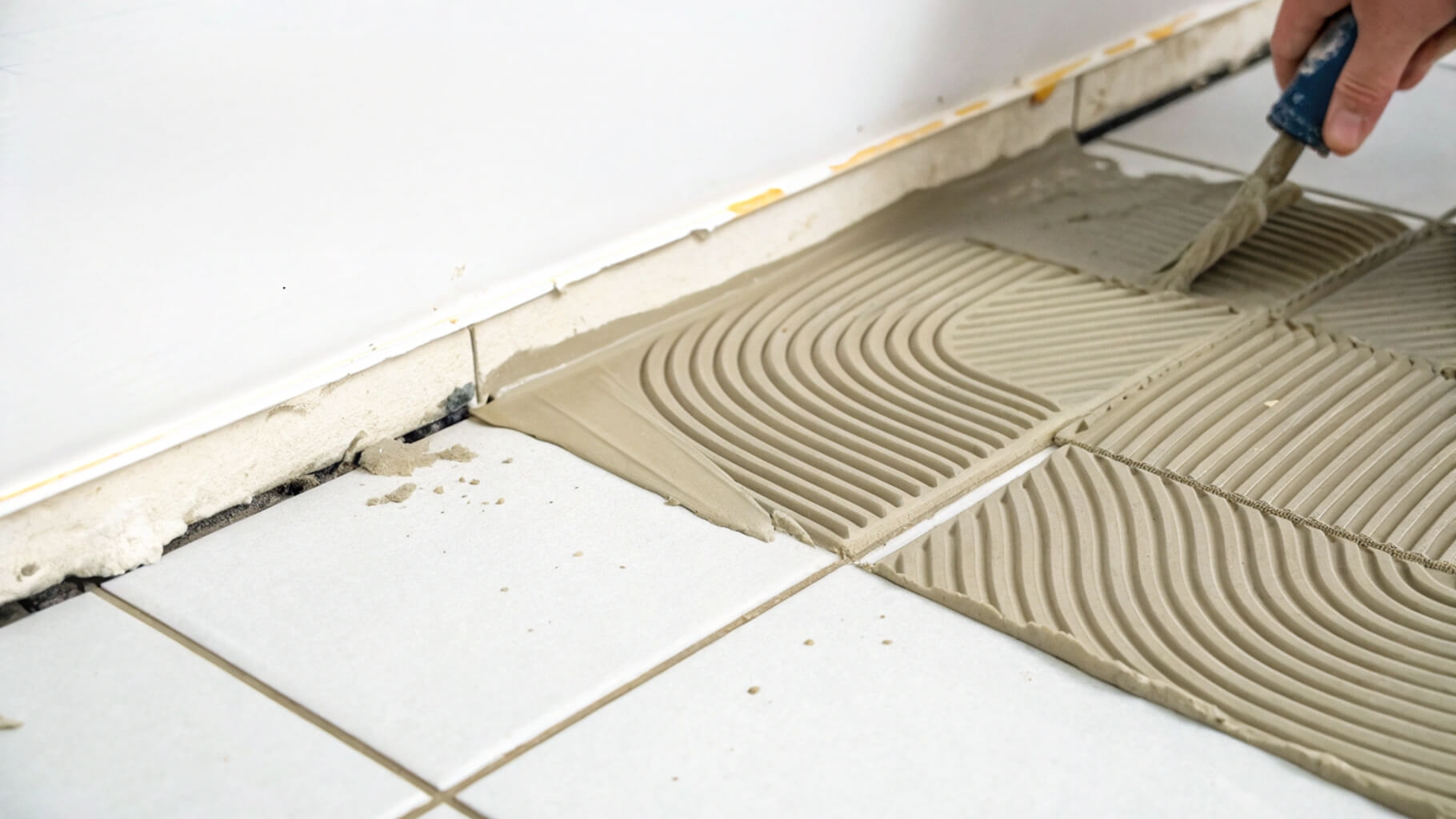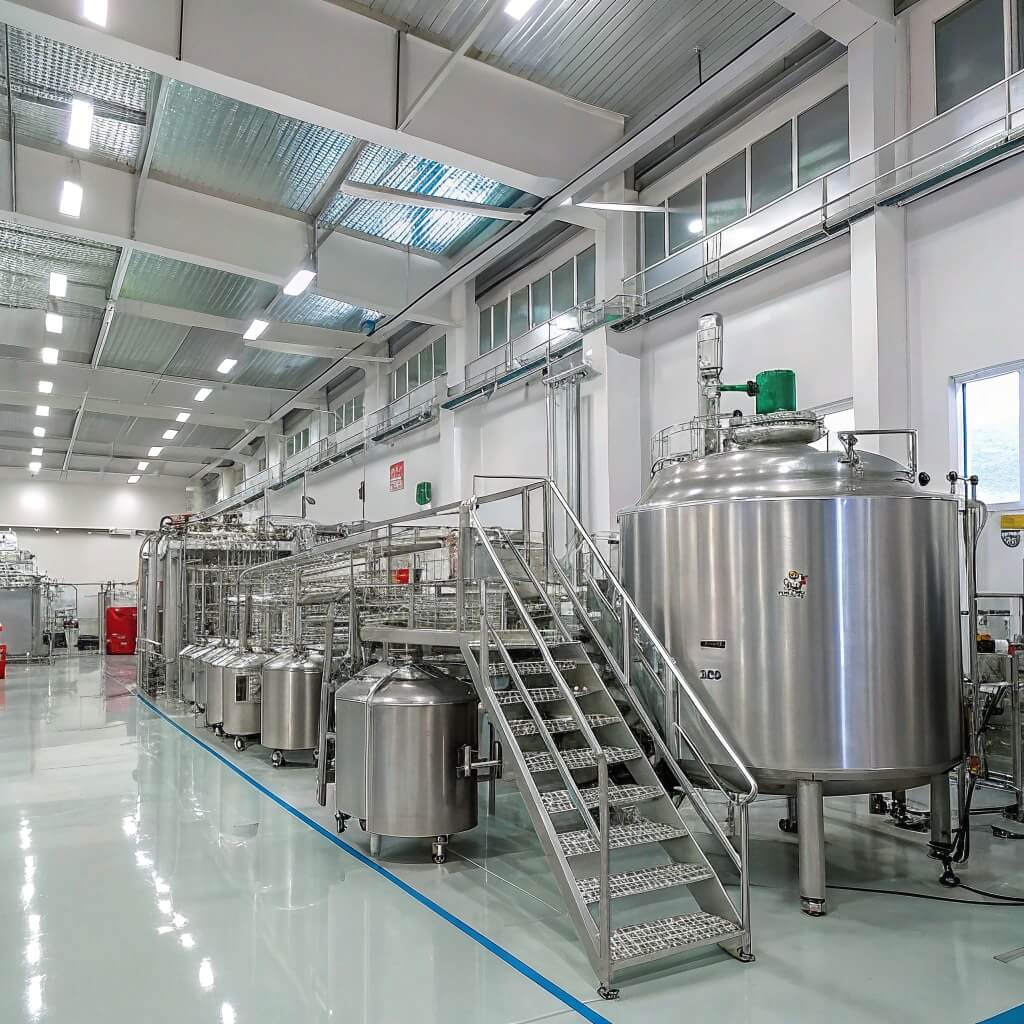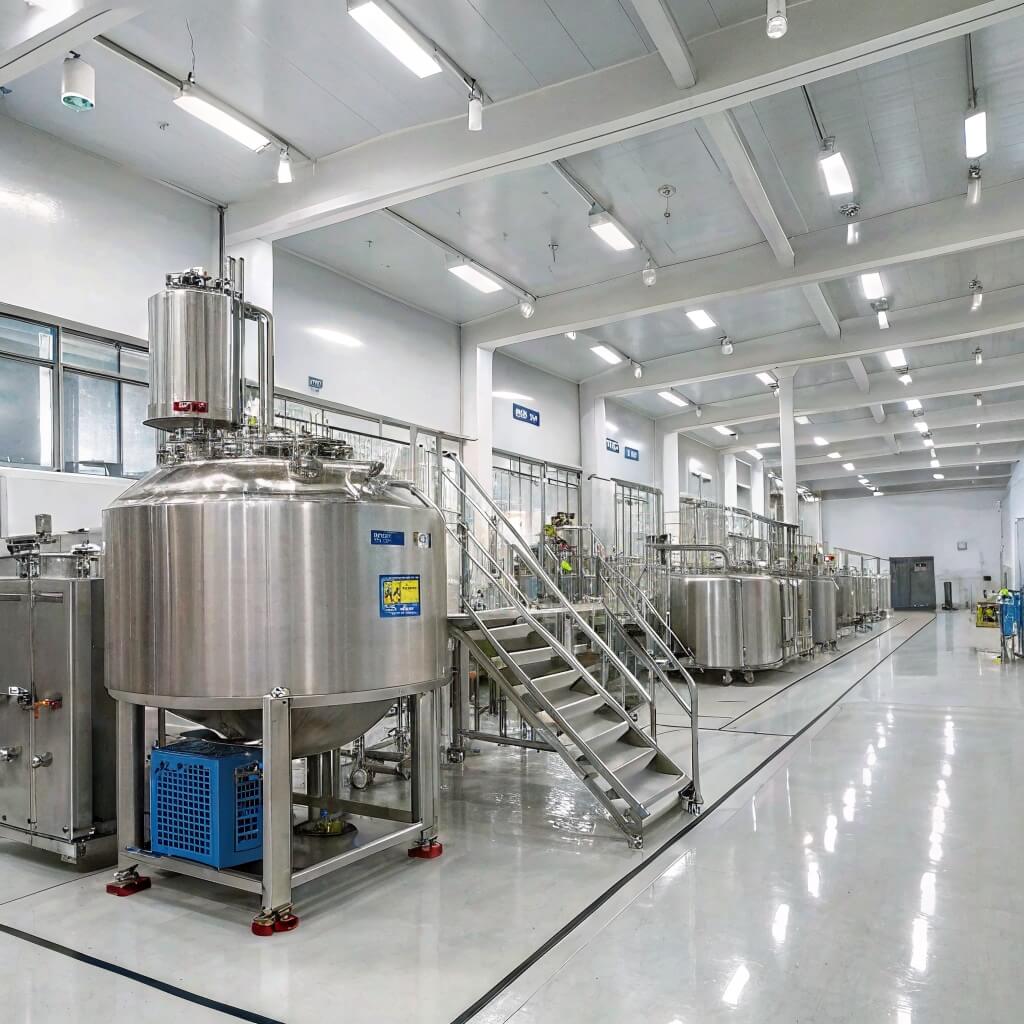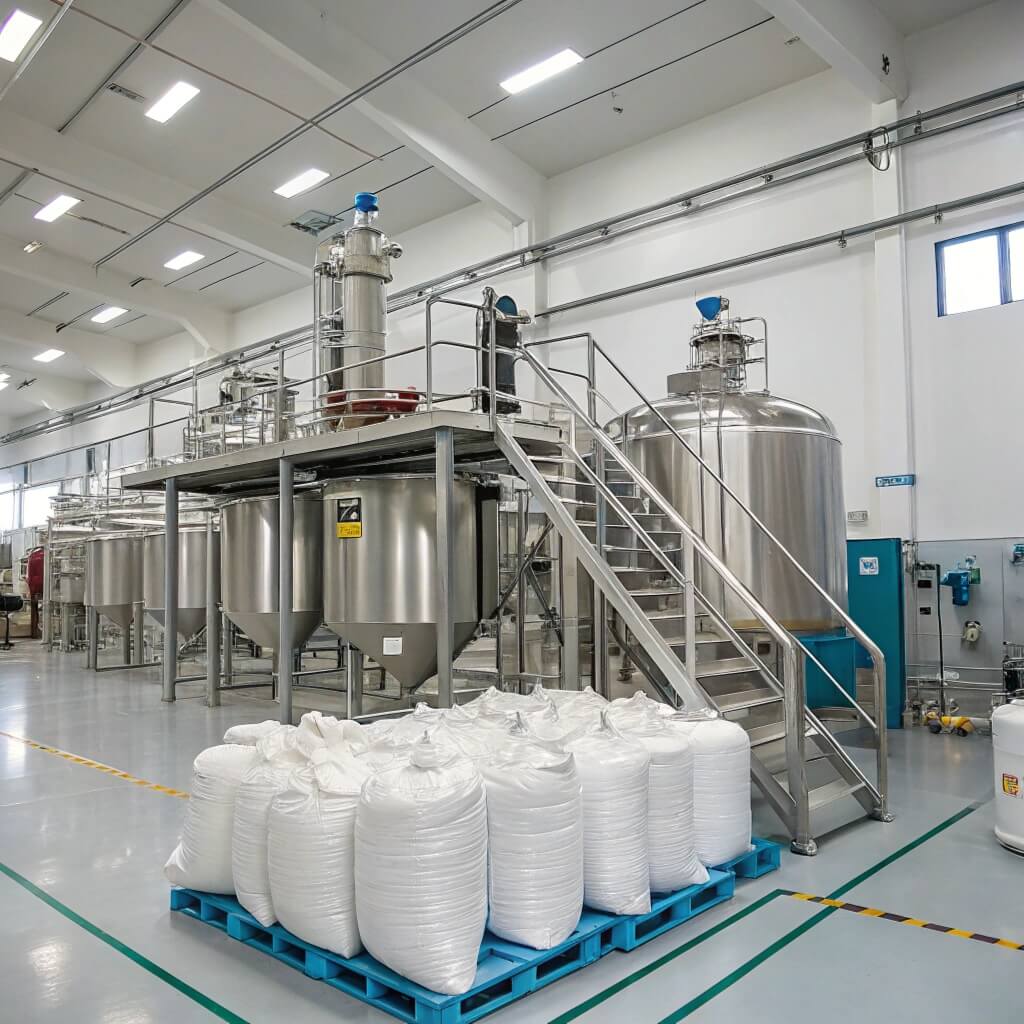Tile adhesives play a critical role in construction, ensuring strong, durable bonds between tiles and surfaces. However, without the right additives, issues like weak adhesion, poor water retention, and reduced workability can arise. Hydroxypropylmethylcellulose (HPMC) is one such key additive that significantly enhances tile adhesive performance.
HPMC is an essential polymer that improves water retention, adhesion strength, and workability in tile adhesives, ensuring long-lasting and reliable installation. It controls hydration, prevents premature drying, and enhances the consistency of the adhesive mix, making it a crucial ingredient in modern tile adhesive formulations.

HPMC enhances water retention, adhesion, and workability in tile adhesives, making it a crucial component for high-performance applications.
Tile adhesives must balance adhesion strength, open time, and workability to meet industry demands. The addition of HPMC allows manufacturers to formulate adhesives that perform optimally under various environmental conditions. The following sections will explore the specific benefits of HPMC in tile adhesives, covering aspects such as water retention, adhesion improvement, setting time, and anti-slip properties.
Why Is HPMC an Essential Ingredient in Tile Adhesives?
Tile adhesives must meet high-performance standards to ensure durability, ease of application, and long-term stability. But what makes Hydroxypropylmethylcellulose (HPMC) such an indispensable component in these formulations?
HPMC is crucial in tile adhesives because it enhances water retention, improves adhesion strength, and optimizes workability. Its properties allow tile adhesives to maintain consistency, prevent premature drying, and improve the overall bonding between tiles and substrates.
The Role of HPMC in Tile Adhesives
HPMC serves multiple functions that significantly impact the quality and usability of tile adhesives. Here’s why it is a key ingredient:
| HPMC-Funktion | Impact on Tile Adhesives |
|---|---|
| Wassereinlagerungen | Extends open time and prevents premature drying of adhesives. |
| Verbesserte Haftung | Enhances bonding strength between tiles and substrates. |
| Workability Enhancement | Provides a smooth, non-sticky consistency for easy application. |
| Durchhangfestigkeit | Prevents tiles from slipping during vertical applications. |
The inclusion of HPMC ensures that tile adhesives perform consistently under different environmental conditions. It plays a critical role in optimizing hydration control, reducing shrinkage cracks, and maintaining adhesive strength throughout the curing process.
Next, we will explore how HPMC verbessert water retention and hydration control, a key factor in maintaining the integrity of tile adhesives.
How Does HPMC Improve Water Retention and Hydration Control?
Tile adhesives require a controlled hydration process to ensure proper bonding and long-lasting performance. Without sufficient water retention, the adhesive may dry too quickly, leading to weak adhesion and poor durability. How does Hydroxypropylmethylcellulose (HPMC) solve this challenge?
HPMC enhances water retention by forming a protective film that slows down moisture evaporation, ensuring optimal cement hydration. This allows the adhesive to maintain its consistency, preventing premature drying and ensuring a strong bond between the tile and substrate.
The Role of HPMC in Water Retention
HPMC effectively manages the water retention and hydration process in tile adhesives. Below are its key contributions:
| HPMC-Funktion | Impact on Tile Adhesives |
|---|---|
| Forms a water-retaining film | Reduces moisture loss, allowing proper hydration. |
| Enhances open time | Prevents premature drying, improving tile positioning time. |
| Improves cement hydration | Ensures full strength development in the adhesive layer. |
| Reduces shrinkage cracks | Minimizes drying stress and enhances durability. |
The Science Behind HPMC’s Water Retention Mechanism
HPMC molecules interact with water to form a gel-like structure that retains moisture within the adhesive mix. This controlled water release ensures that cement particles have enough hydration time, was zu folgendem Ergebnis führt:
- Stronger adhesion: The adhesive bonds more effectively with the tile and substrate.
- Improved workability: The mixture remains smooth and easy to apply.
- Longer open time: Workers can adjust tile placement without rushing against drying constraints.
HPMC is particularly beneficial in hot or dry environments, where moisture evaporation[^1] is accelerated. By maintaining a stable hydration process, it ensures that the adhesive does not dry out before achieving full strength.
[^1]: Understanding moisture evaporation's impact can help in selecting the right adhesive for your needs.
In the next section, we will examine how HPMC impacts adhesion and bonding strength, a critical factor in ensuring durable tile installations.
What Is the Impact of HPMC on Adhesion and Bonding Strength?
A strong, durable bond is essential for tile adhesives to withstand mechanical stress and environmental factors. But how does Hydroxypropylmethylcellulose (HPMC) enhance adhesion and bonding strength in these formulations?
HPMC improves adhesion by optimizing the cement hydration process, enhancing bonding strength, and preventing premature drying. It ensures a more uniform dispersion of cement particles, creating a stronger interface between the tile adhesive and substrate.
How HPMC Enhances Adhesion Performance
The impact of HPMC on tile adhesive bonding strength can be broken down into several key mechanisms:
| HPMC-Funktion | Impact on Adhesion and Bonding Strength |
|---|---|
| Improves cement particle dispersion | Creates a uniform bond with minimal voids. |
| Enhances hydration efficiency | Leads to stronger chemical bonding and mechanical strength. |
| Prevents premature drying | Ensures adequate curing for maximum adhesion. |
| Increases tensile strength | Provides higher resistance to external forces. |
The Adhesion Mechanism of HPMC in Tile Adhesives
HPMC enhances bonding strength by improving both mechanical interlocking Und chemical adhesion:
- Mechanical Interlocking: HPMC allows the cementitious components in tile adhesives to flow and settle evenly, filling surface pores and creating a more effective mechanical bond.
- Chemical Adhesion: By optimizing cement hydration, HPMC contributes to stronger chemical bonding, increasing overall tensile and shear strength.
Comparing Adhesion Strength With and Without HPMC
Below is a comparison of adhesion performance in tile adhesives formulated with and without HPMC:
| Eigentum | Ohne HPMC | Mit HPMC |
|---|---|---|
| Bindungsstärke | Lower due to poor water retention | Significantly improved |
| Hydration Efficiency | Uneven due to rapid moisture loss | Controlled and optimized |
| Verarbeitbarkeit | Difficult to spread evenly | Smooth, consistent application |
| Crack Formation | Higher risk of cracks | Reduced shrinkage cracks |
By stabilizing moisture levels and optimizing hydration, HPMC significantly enhances bonding strength, leading to longer-lasting and more durable tile installations.
Next, we will explore how HPMC improves the workability and consistency of tile adhesives, ensuring ease of application and smooth performance.
How Does HPMC Improve the Workability and Consistency of Tile Adhesives?
Applying tile adhesives should be effortless, allowing workers to spread the mixture smoothly while ensuring a uniform bond. However, poor consistency can lead to uneven application, reduced adhesion, and increased material waste. So how does Hydroxypropylmethylcellulose (HPMC) enhance the workability and consistency of tile adhesives?
HPMC improves workability by regulating viscosity, enhancing spreadability, and maintaining a stable, non-sticky consistency. It allows tile adhesives to remain smooth and easy to apply, reducing effort while ensuring optimal coverage.
The Role of HPMC in Workability and Consistency
The inclusion of HPMC in tile adhesives directly influences several key performance factors:
| HPMC-Funktion | Impact on Workability and Consistency |
|---|---|
| Viskositätskontrolle | Provides a smooth, uniform texture, preventing lumps. |
| Improved Spreadability | Reduces drag resistance, making application easier. |
| Verbesserter Zusammenhalt | Ensures even coverage without separation. |
| Verhindert vorzeitiges Austrocknen | Keeps the adhesive workable for an extended period. |
How HPMC Optimizes Workability
-
Regulating Viscosity
- HPMC controls the viscosity of the tile adhesive, ensuring a smooth, lump-free consistency that allows for even spreading.
- Different grades of HPMC enable manufacturers to tailor adhesive flow properties to specific application needs.
-
Reducing Stickiness
- A well-formulated adhesive should not stick excessively to tools, making it easier for workers to handle and apply.
- HPMC prevents excessive tackiness, allowing for effortless troweling and shaping.
-
Maintaining Stability Over Time
- Without proper stabilization, adhesives may separate, leading to uneven coverage.
- HPMC helps maintain a consistent texture throughout the application process, preventing phase separation.
Workability Comparison: With and Without HPMC
| Workability Factor | Ohne HPMC | Mit HPMC |
|---|---|---|
| Ease of Spreading | High resistance, difficult to apply | Smooth and effortless |
| Konsistenz | May contain lumps, uneven mix | Uniform, stable mixture |
| Application Time | Short due to rapid drying | Extended for precise tile placement |
| Tool Adhesion | Sticks excessively to trowels | Controlled stickiness for better handling |
Mit HPMC, tile adhesives become easier to mix, spread, and control, leading to higher efficiency and better tile installations.
In the next section, we will discuss how HPMC influences open time and setting time, ensuring flexibility in tile positioning.
How Does HPMC Influence Open Time and Setting Time?
Tile adhesives need a balance between open time and setting time to allow proper placement while ensuring strong bonding. If the adhesive dries too fast, workers may struggle to adjust tiles. If it sets too slowly, delays occur. Wie reguliert Hydroxypropylmethylcellulose (HPMC) diesen Prozess?
HPMC extends open time by retaining moisture in the adhesive, preventing premature skin formation. It also ensures a controlled setting process, allowing proper hydration and bond development.
The Role of HPMC in Open Time and Setting Time
| HPMC-Funktion | Einfluss auf die Offenzeit und Abbindezeit |
|---|---|
| Feuchtigkeitsspeicherung | Keeps adhesive workable for longer periods. |
| Prevents Skin Formation | Allows tiles to be adjusted before the surface dries. |
| Regulates Hydration | Ensures cement fully reacts for maximum strength. |
| Steuert die Einstellungszeit | Prevents excessive delays while maintaining proper curing. |
How HPMC Optimizes Open Time and Setting Time
-
Extending Open Time
- Open time refers to the period during which tiles can be placed without losing adhesion.
- HPMC prevents rapid moisture loss, keeping the adhesive fresh and adjustable for a longer time.
-
Preventing Premature Skin Formation
- In high temperatures or dry conditions, adhesives can form a surface skin too quickly.
- HPMC delays skin formation, ensuring better tile bonding and reducing installation errors.
-
Ensuring Controlled Setting
- Cement-based adhesives require proper hydration for full strength development.
- HPMC regulates water availability, allowing cement to cure gradually, preventing weak bonds.
Comparing Performance With and Without HPMC
| Eigentum | Ohne HPMC | Mit HPMC |
|---|---|---|
| Offene Zeit | Short, requiring quick placement | Erweitert, ermöglicht Anpassungen |
| Hautbildung | Rapid, reducing bonding quality | Delayed, ensuring strong adhesion |
| Einstellzeit | Unvorhersehbar, Risiko schwacher Bindungen | Kontrolliert, wodurch die Haltbarkeit verbessert wird |
| Workability in Dry Climates | Schlecht, Kleber trocknet zu schnell | Optimiert, erhält die Leistung |
By regulating open time and setting time, HPMC verbessert die Flexibilität und Zuverlässigkeit von Fliesenklebern, ensuring successful installations.
Next, we will explore how HPMC improves anti-slip and sag resistance, particularly in vertical applications.
What Are the Anti-Slip and Sag Resistance Benefits of HPMC?
When installing tiles on vertical surfaces, adhesives must hold tiles in place without slipping. Poor formulation leads to sagging, misalignment, and costly rework. How does Hydroxypropyl Methylcellulose (HPMC) help prevent these issues?
HPMC improves sag resistance by enhancing adhesive cohesion, increasing viscosity, and stabilizing the mixture. It allows tiles to remain in position after placement, preventing downward movement on vertical applications.
How HPMC Enhances Anti-Slip and Sag Resistance
| HPMC-Funktion | Impact on Anti-Slip and Sag Resistance |
|---|---|
| Increases Adhesive Viscosity | Provides a thicker consistency, reducing tile movement. |
| Enhances Cohesion | Strengthens internal bonding, preventing adhesive flow. |
| Controls Moisture Retention | Prevents excessive water loss, maintaining stability. |
| Reduces Slippage | Keeps tiles fixed in their intended position. |
Why Sag Resistance Matters in Tile Adhesives
-
Prevents Tile Movement on Walls
- Without sag resistance, heavy tiles may slip downward before the adhesive fully sets.
- HPMC reinforces the adhesive’s internal structure, wodurch die Fliesen an ihrem Platz bleiben.
-
Ensures Even Bonding Across Large Areas
- Inconsistent adhesive consistency can lead to uneven tile surfaces.
- HPMC stabilizes the mixture, ensuring uniform adhesion and proper tile alignment.
-
Reduces the Need for Tile Spacers
- Traditional methods require spacers to hold tiles in position.
- With HPMC, adhesives provide better grip, minimizing the need for extra support.
Leistungsvergleich: Mit und ohne HPMC
| Eigentum | Ohne HPMC | Mit HPMC |
|---|---|---|
| Durchhangfestigkeit | Weak, tiles may slip | Strong, tiles stay in place |
| Adhesive Stability | Inconsistent, risk of separation | Stable, maintains uniform mix |
| Workability on Vertical Surfaces | Difficult to control application | Smooth and easy placement |
| Need for Additional Support | Requires spacers for alignment | Minimal spacers needed |
Durch die Verbesserung anti-slip and sag resistance, HPMC ensures precise tile positioning and reduces installation errors, especially in large-format and vertical applications.
Next, we will conclude why HPMC is a key component in high-performance tile adhesives and summarize its essential role in modern formulations.
Conclusion: Why HPMC Is a Key Component in High-Performance Tile Adhesives?
Choosing the right tile adhesive is crucial for achieving strong, durable, and efficient tile installations. Hydroxypropylmethylcellulose (HPMC) has proven to be an essential additive, significantly enhancing the performance of tile adhesives by improving water retention, adhesion strength, workability, setting time, and sag resistance.
Throughout this discussion, we have explored the various ways HPMC optimizes tile adhesive performance, einschließlich:
- Enhancing Water Retention: Prevents premature drying, ensuring optimal cement hydration.
- Improving Adhesion Strength: Strengthens bonding between tiles and substrates, reducing the risk of failures.
- Optimizing Workability: Provides a smooth, easy-to-apply consistency, reducing application effort.
- Regulating Open and Setting Time: Extends work time while allowing controlled curing for long-lasting strength.
- Increasing Anti-Slip and Sag Resistance: Prevents tiles from shifting or sliding, especially in vertical applications.
For manufacturers and contractors seeking reliable, high-performance tile adhesives, HPMC remains a critical component that ensures quality, consistency, and ease of use. Its multifunctional benefits help achieve professional-grade tile installations while improving efficiency and reducing material waste.
If you're looking to enhance your tile adhesive formulations or explore high-quality HPMC for your applications, contact us today for expert recommendations and tailored solutions.
Häufig gestellte Fragen
What is the function of HPMC?
Hydroxypropylmethylcellulose (HPMC) serves as a multifunctional additive in various industries. In construction materials, it enhances water retention, adhesion, workability, and sag resistance in cement-based products like tile adhesives, mortars, and plasters. It also acts as a thickener, stabilizer, and film-forming agent in pharmaceuticals, food, and personal care products.
What is the best adhesive to use to stick something to a tile?
The best adhesive depends on the material being bonded. For tile installations, cement-based tile adhesives modified with HPMC offer the strongest and most durable bonds. For lightweight applications, epoxy adhesives oder polyurethane-based adhesives provide excellent adhesion to smooth surfaces like ceramic and porcelain tiles.
Was ist die Funktion der HPMC-Beschichtung?
HPMC coatings are widely used in the pharmaceutical, food, and construction industries. In pharmaceuticals, HPMC serves as a film-coating agent for tablets, improving moisture protection and controlled drug release. In food, it acts as a Stabilisator und Verdickungsmittel, while in construction, it enhances coating adhesion, durability, and water resistance in paints and protective layers.
What is HPMC for Drymix mortar?
In drymix mortar, HPMC improves water retention, enhances adhesion, and optimizes workability. It prevents premature drying, ensuring proper cement hydration and reducing cracking. HPMC also contributes to the geschmeidige Konsistenz of the mortar, allowing easier application and improved final strength in construction applications.




